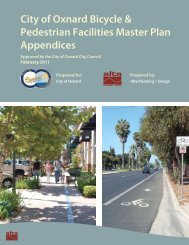Santa Clara River Trail Final Master Plan - Development Services ...
Santa Clara River Trail Final Master Plan - Development Services ...
Santa Clara River Trail Final Master Plan - Development Services ...
You also want an ePaper? Increase the reach of your titles
YUMPU automatically turns print PDFs into web optimized ePapers that Google loves.
<strong>Santa</strong> <strong>Clara</strong> <strong>River</strong> <strong>Trail</strong> <strong>Plan</strong><br />
back to the first year of the project using a discount rate. The discount rate can be defined a variety of<br />
ways. For this benefit-cost analysis, it is defined as the opportunity cost of the initial investment, or the<br />
interest rate that the capital needed for the project could return if invested in an alternative venture. 2<br />
This benefit-cost analysis also uses a low and a high discount rate to account for the uncertainty in the<br />
actual discount rate. A lower discount rate makes it more likely that a project will see a positive net<br />
benefit.<br />
Table 8 shows the NPV benefit-cost results over the 30-year lifetime of the pathway. The benefit-cost<br />
ratio is determined by dividing the estimated benefits of the pathway in dollars by the estimated costs in<br />
dollars. A benefit-cost ratio higher than one means the project has more benefits than costs over its<br />
lifetime. A benefit-cost ratio of one means benefits and costs are equal. A benefit-cost ratio less than one<br />
means the project costs outweigh the benefits.<br />
For the 5 percent and 2.5 percent real discount rates, the best estimate benefit-cost ratios are 7.77 and<br />
10.62, respectively. Thus, the environmental, economic, public health, and social benefits the community<br />
would experience as a result of the pathway exceed the cost of the pathway by three to four times. The<br />
“low” estimates are extremely conservative and greatly underestimate the actual benefits. In this case the<br />
benefit-cost ratios for the 5 percent and 2.5 percent discount rates are 2.54 and 3.47, respectively. Under<br />
this scenario, the cost of constructing and maintaining the pathway would be very close to the benefits.<br />
Using the “high” estimates, the benefit-cost ratios for the 5 percent and 2.5 percent discount rates are<br />
26.77 and 36.62, respectively.<br />
Table 8: Net Present Value Benefit-Cost Results<br />
Benefit-Cost Analysis<br />
Net Present Value of<br />
Benefits<br />
Net Present Value of<br />
Construction and<br />
Maintenance Costs<br />
Benefits with 5% discount rate<br />
High Estimate $185,559,894 $6,932,211 26.77<br />
Best Estimate $53,839,319 $6,932,211 7.77<br />
Low Estimate $17,576,281 $6,932,211 2.54<br />
Benefits with 2.5% discount rate<br />
High Estimate $274,760,363 $7,503,761 36.62<br />
Best Estimate $79,720,410 $7,503,761 10.62<br />
Low Estimate $26,025,372 $7,503,761 3.47<br />
Benefit-Cost Ratio<br />
The project costs shown in Table 8 include the NPV of annual maintenance and operating costs, as<br />
required for benefit-cost analysis. Total project costs are higher for the 2.5 percent discount rate case<br />
2 To give an example of discounting, given a discount rate of 7 percent, $5,000 in be nefits rece ived ten years from now has the same value as $2,542 in<br />
benefits received now. In other words, if one was to invest $2,542 now with interest rates at 7 percent, in ten years, that money would be worth $5,000.<br />
City of Oxnard | 69
















